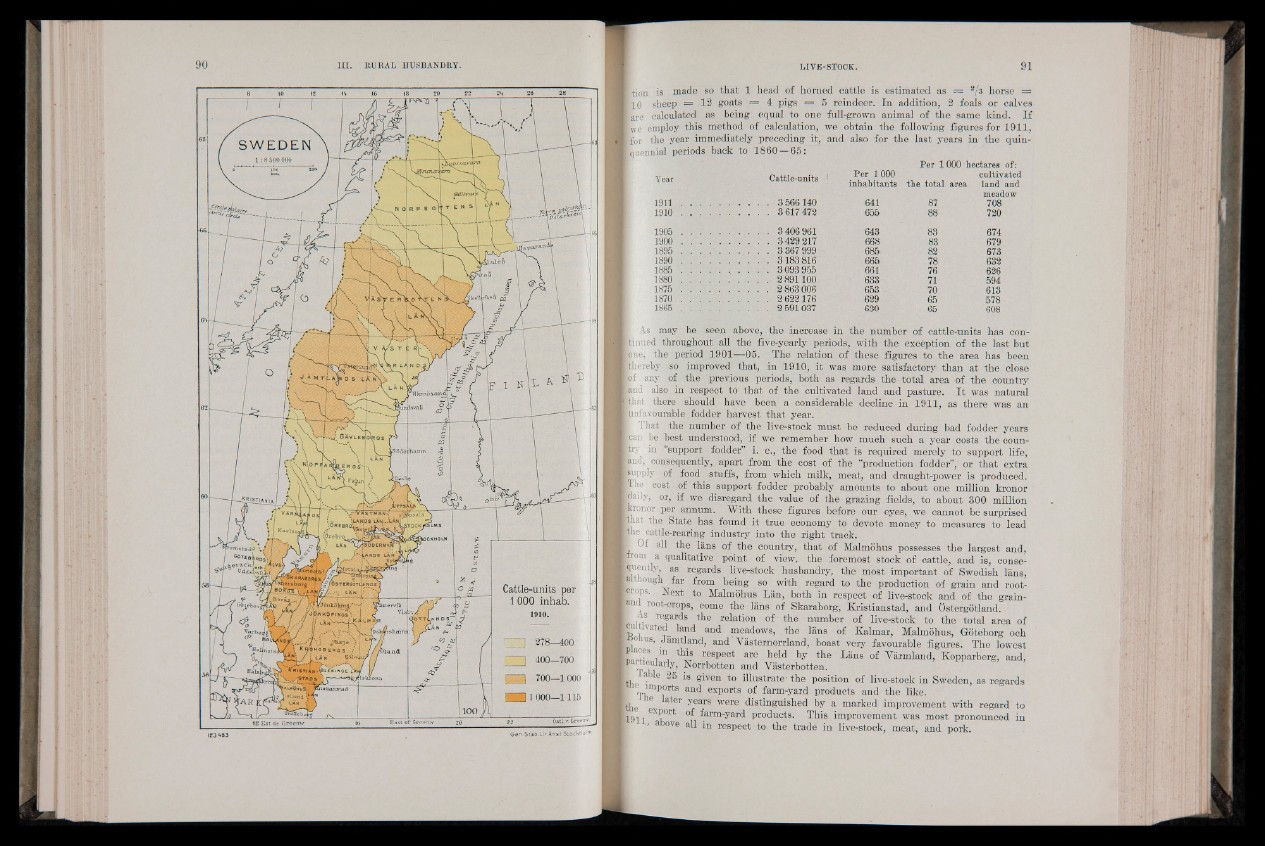
ttion is made so that 1 head of horned cattle is estimated as = 2/3 horse =
[lO sheep = 12 goats = 4 pigs = 5 reindeer, in addition, 2 foals or calves
fare calculated as being equal to one full-grown animal of the same kind. I f
[we employ this method of calculation, we obtain the following figures for 1911,
[for the year immediately preceding it, and also for the last years in the quinfquennial
periods back to 1860 — 65:
Per 1000 hectares of:
Year Cattle-units 1 Per 1000
inhabitants the
cultivated
total area land and
1911 . . . . . . . . . . 3566140 641 87
meadow
708
1910 . . . ........................ 3 617 472 655 88 720
1905 . . . . . . . . . . 3406961 643 83 674
1900 . . . . .................... 3 429 217 668 83 679
1895 . . . ........................ 3367999 685 82 673
1890 . . . ........................ 3 183 816 665 78 632
1885 . . . ........................ 3 093 955 661 76 626
1880 . . . ........................ 2 891 100 633 71 594
1875 . . . ........................ 2 863 006 653 70 613
1870 . . . ........................ 2 622176 629 65 578
1865 ........................ 2 591 037 630 65 608
may be seen above, th e increase in th e number of cattle-units has con-
Itinued throughout all the five-yearly periods, with the exception of the last but
lone, the period 1901—05. The relation of these figures to the area has been
■thereby so improved that, in 1910, it was more satisfactory than at the close
■of any of the previous periods, both as regards the total area of the country
land also in respect to that of the cultivated land and pasture. It was natural
■that there should have been a considerable decline in 1911, as there was an
[unfavourable fodder harvest that year.
That the number of the live-stock must be reduced during bad fodder years
le a n be ¡ best understood, if we remember how much such a year costs the coun-
jtr y in support fodder” i. e., the food that is required merely to support life,
fend, consequently, apart from the cost of the “production fodder”, or that extra
feupply of food stuffs, from which milk, meat, and draught-power is produced.
■The cost, of this support fodder probably amounts to about one million kronor
B a ily , or, if we disregard the value of the grazing fields, to about 300 million
! kronor per annum. With these figures before our eyes, we cannot be surprised
th a t the State has found it true economy to devote money to measures to lead
Ithe cattle-rearing industry into the right track.
I Of all the Ians of the country., that of Malmohus possesses the largest and,
■•om a qualitative point of view, the foremost stock of cattle, and is, conse-
»uently, as regards live-stock husbandry, the most important of Swedish Ians,
although far from being so with regard to the production of grain and root-
jerops. Next to Malmohus Lan, both in respect of live-stock and of the grain-
f m m oome Ians of Skaraborg, Kristianstad, and Ostergotland.
As regards the relation of the number of live-stock to the total area of
cu tivated land and meadows, the Ians of Kalmar, Malmohus, Goteborg och
j o us, Jamtland, and Vastemorrland, boast very favourable figures. The lowest
a<??s 111 respect are held by the Làns of Varmland, Kopparberg, and,
|artieularly, Norrbotten and Yasterbotten.
L, a âs given to illustrate' the position of live-stock in Sweden, as regards
I rp,lmp1°rts and exP°rts of farm-yard products and the like.
I e later years were distinguished by a marked improvement with regard to
11911 eX?0rt farm-yard products. This improvement was most pronounced in
r ’ ove all in respect to the trade in live-stock, meat, and pork.